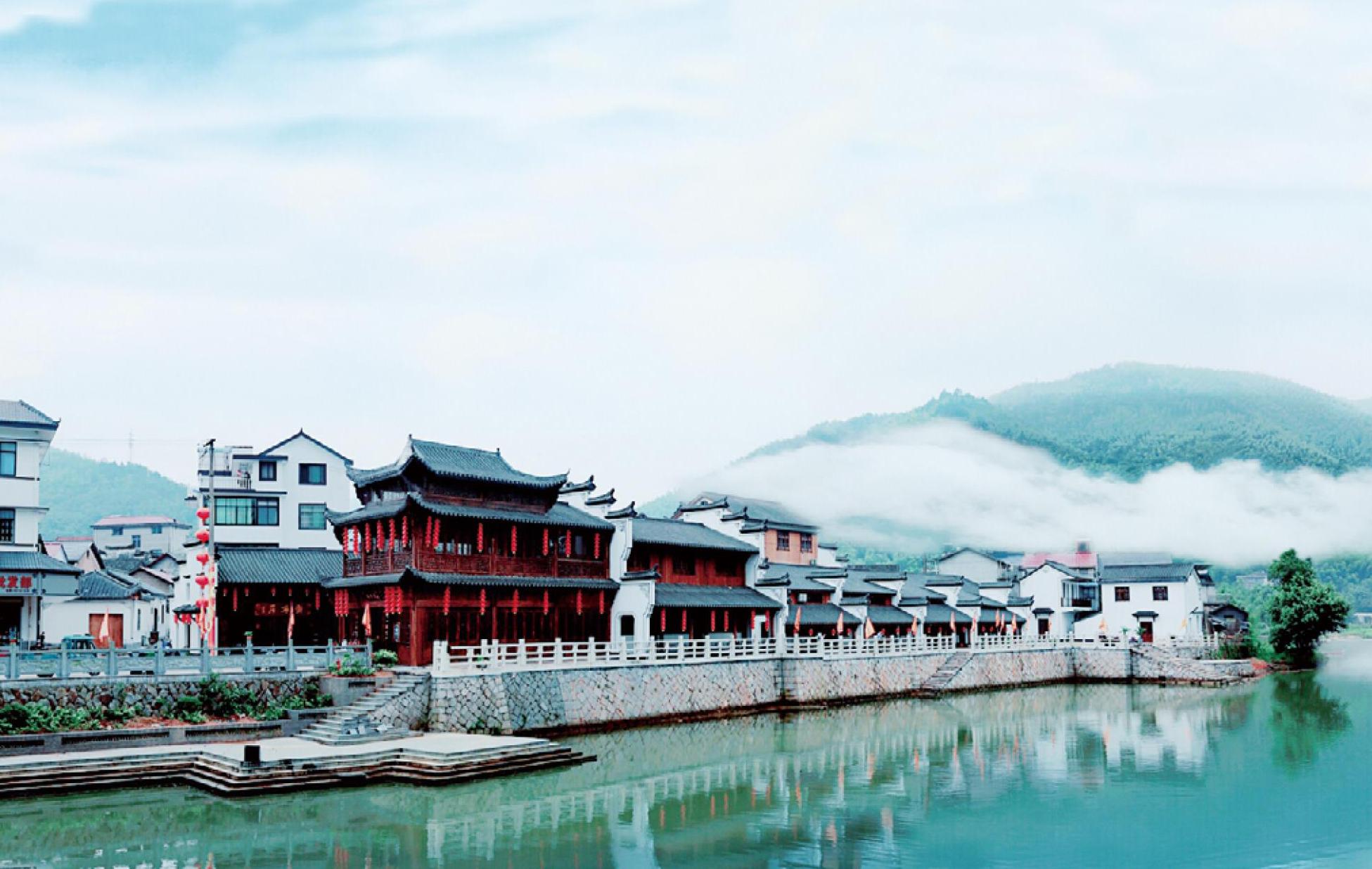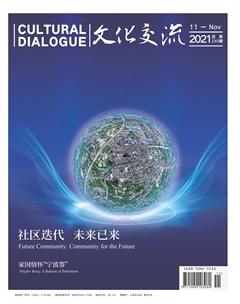竹海古镇 偃王故里
方俊 罗意 刘佳蓓

千年风雨,白石古城。龙游溪口镇历史悠久,西周时期即有人定居。秦王政在公元前222年于姑蔑之地署太末县。唐高祖武德四年,置縠州,又析置太末、白石二县;八年废縠州,白石入信安里,仍遗婺州。白石县位于县南三十五里白石山处,因白石山山石纯白,县以此得名。白石县域东连太末,西至金华,北接太末,南攘遂昌,县衙位于镇区西北处。《太平寰宇记》卷之九十七《江南道九 · 衢州》、万历志卷之一《舆地 · 沿革》等文献均有记载。
溪口借助于水陆交通的便利优势,最终成为重要的文化商业中心,是古时龙游的商贸重镇。素有“竹海古镇、偃王故里”美称,先后被评为浙江省小城镇综合改革中心镇、全国绿化造林百强乡镇,是省政府确定的浙江省200个中心镇之一,衢州市9个全国重点镇之一,也是衢丽(衢州、丽水)“美丽经济带”必经节点。溪口镇党委、政府高度重视,积极响应上级战略部署,编制溪口镇“千年古城”复兴试点工作计划,积极申报第二批千年古城复兴试点。
作为一个拥有上千年历史的古镇,厚重的历史底蕴是溪口最大的特色,其遗存的历史文化建筑、工业历史建筑、人文地标、商帮文化、徐偃王“仁義” 文化、“金兰”文化、奋斗精神文化等构成了溪口丰富的文化内涵。好地方孕育好人才,溪口自古地灵人杰,先后出现徐偃王、刘章、劳景贤等几十位人才。镇内文物古迹底蕴丰富,拥有省、县三级文物保护单位10个,是展现地域魅力的窗口。该镇是第六批浙江省历史文化名镇,溪口村是全省第五批历史文化(传统)村落保护利用项目优秀村。
古镇沿着灵山江而建,具有独特的空间形态格局。放眼四望,有明清古建筑30余栋,分布在古街两侧。有古商铺、古作坊和古民居。建筑整体形式、尺度、色彩具有典型江南地区传统风格,既有徽派建筑特色,又融入龙游地方文化个性,古商铺、古民居精雕细作,用材考究,部分建筑取材硕大,做工精细,传统砖雕、木雕非常普遍。内容丰富有特色的建筑风格,形成了天然的建筑博物馆。
老城新貌,美丽城镇。历史文化街区改造提升、新城开发建设和乡村振兴高质量发展加快推进。镇区小城镇环境综合整治工程全面完成,基础设施显著完善,全力完成洁化、绿化、亮化、序化。历史文化核心区基本构建完成,溪口历史文化街区和灵山历史文化街区,恢复和构建古城原有街区历史风貌和人文风情。以“溪口公社,快乐老家”为主题,黄泥山小区为核心,建设辐射溪口乃至龙南“一镇三乡”的全省首个乡村版未来社区正式投入使用,集优良宜居、创新创业、邻里和睦、智慧治理于一体。围绕打造承载溪口记忆的千年古城目标,加大对古城的保护与挖掘力度,保护好历史文物,让亟待保护的文物“活下去”,让已经保护的文物“活起来”。溪口老街历史建筑等有物质形态的文化场所保护,在保护中有序推进古城开发。
着眼擦亮古城文化基底,挖掘方山茶、断头龙、徐偃王庙会等非遗文化遗产,追溯各类文化的生命周期和表现形式。积极谋划建设科技含量较高的溪口非物质文化遗产展示馆、徐偃王文化园等项目,提升溪口居民和游客对千年古城文化的知晓度和认同感。对老街和历史文化街区进行规划建设,已完成溪口历史文化街区一期、二期以及灵山历史文化街区的规划建设,天妃宫古建修复,加快推进老街三期沿街和沿江立面改造、禹王庙和八字门厅修复工程,老街再现昔日繁华。
利用本土文化特色,大力开展有礼指数主题实践活动。举办以运动、党建、亲子为主题的研学活动。大力发展竹运会、长桌宴等特色文化活动,打响“百人长桌宴”“花样竹运会”“热闹夜集市”系列品牌,文化旅游品牌影响力不断提升。
瞄准建设现代化浙西新明珠的总目标,打响“衢州有礼、天下龙游”城市品牌。扎实推进千年古城复兴工作,统筹加强遗迹保护、文化传承、产业转型、民生改善和环境提升,打造生态宜居、水清景美、安居乐业的美丽古城,浙江“千年古城”复兴计划中的浙西明珠。
在保护中开发、在开发中传承、传承中提升,推动保护、开发、传承相得益彰,实现千年古城高质量复兴。立足溪口独特资源优势和文化特色,以千年古城、商旅重镇、美丽城镇为总体定位,全力打造全省独具魅力的传统文化复兴名城。
——千年古城。依托“商帮文化、徐偃王‘仁义’文化”的文化地位,以溪口历史文化古街区、灵山历史文化古街区、溪口乡村未来社区“两街一社区”为核心,充分挖掘文化资源,打造以白石县治风情为底色、非遗传承为特色,老字号商铺、乡愁民宿、地域特色餐饮为主要业态,集山魂水韵文脉乡愁于一体的特色古城。
——龙南重镇。发挥区位优势,重点促进溪口与沐尘、庙下、大街“一镇带三乡”联动发展,积极发展精品农业、竹木加工、休闲养生等产业,着力打造产业兴旺的龙游南部重镇。
——美丽城镇。以打造龙游县域副中心为目标,以溪口乡村未来社区为引擎,探索新时代城乡融合高质量发展模式,从智慧城市、品质城市、文明城市三个维度,推动溪口高质量建设美丽城镇,全面改善社会民生,提升数字化、精细化管理水平。
到2025年,实现溪口镇全领域、全方位的复兴,彰显千年古城在新时代的新风貌新风采,在历史遗存保护、传统文化传承弘扬、社会民生改善、生态环境美化等方面都有长足进步。到2035年,古城人居环境、基础设施、服务配套、风貌塑造等方面全面提升,白石县治历史风貌全面重现,商帮文化魅力风采全面彰显,城市文化软实力和影响力显著增强。
历史遗存保护开发显著加强。历史文化古街区得到有效保护和开发,名人故居、景迹点和古桥等历史古建得到进一步保护、修缮和重建,古村落风貌进一步改造提升,国家级、省级、区级文保单位申报取得新突破。
文化传承与弘扬显著增强。溪口商帮文化成为衢州市新的一张文化“金名片”,文化溯源研究取得较大进展,溪口古城形象品牌树立,非物质文化遗产有效传承。建成古城文化“会客厅”、非物质文化遗产展示馆、徐偃王文化园等。生态环境显著美化。自然山水景观风貌得到有效保护,水体质量明显改善,古城风貌明显提升。到2025年,完成沿江立面改造、完成污水处理终端提升改造等。
提升古街歷史文化街区。加强历史遗存保护与开发,大力推动文化传承与弘扬,以文化旅游业为重点发展方向,着力提升老城居民生活品质提升。进一步打造历史文化保护传承区。强化古城历史建筑、文保单位、非物质文化遗产等历史文化资源的保护、开发与传承弘扬等功能。聚焦遗存保护与文化传承。坚持在保护中开发、在开发中保护,统筹处理好保护与传承的关系。加强对古迹遗存的科学修缮、修复和重建,加强优秀传统文化的溯源研究,加大特色文化的挖掘推广,传承好非物质文化遗产。
启动古城整治修复工程。开展历史遗存保护修缮与再利用。依据历史资料结合初唐时代建筑风格复原古县衙,对溪口历史文化古街区进行三期建设,对灵山历史文化古街区进行整体景观风貌提升,修葺徐堰王庙和禹王庙,打造文化公园。设计白石县千年古城文化标签吉祥物,提升旅游标识系统,进行灯光亮化改造。古城建筑风貌在外观上要与古城整体风貌相协调,内部根据业态布局和市场需要来开发,营造古城氛围,生动展现初唐古城的历史文化形象。
打造“智慧古城”。通过建设龙南旅游集散中心,提升溪口的智慧旅游服务能力和水平。运用5G、大数据等现代信息技术手段,在龙南旅游集散中心通过建立并完善智慧文保地图实现数字化导览、多维度展示,将历史文化串珠成链。包含但不限于古城内及周边景点查询、云上景点展示、全景旅游体验、电子旅游地图导览、交通线路查询、旅游线路推荐、商业配套查询、旅游安全救援等各大场景,逐步实现“一部手机游溪口”。
促进优秀文化传承。建设古城文化“会客厅”和非物质文化遗产展示馆。打造云客厅和古城数字沙盘,满足线上和线下接待、会晤、游憩等多样化功能,将其打造成为古城标志性景观。积极谋划建设科技含量较高的溪口非物质文化遗产展示馆,以文化主题教育、社会实践和文化论坛等形式,展现千年古城文化。
加快古城产业优化。打造旅游服务业。围绕灵山、溪口历史文化古街建设文化旅游风情街,盘活街区及周边的旅游业,大力发展具有浓厚乡土特色的龙游菜系和小吃产业文化,丰富业态,形成浓厚的商业氛围。建设竹溪剧场作为演绎溪口历史文化的场所,以现代的方式再现历史记忆。大力发展竹运会、长桌宴、星星的市集等特色文化活动,打响“百人长桌宴”“花样竹运会”“热闹夜集市”等系列品牌。鼓励年轻创客来溪口发展,将老街打造成一条生态休闲、文旅融合的地方特色休闲旅游街、便民消费街、农民创业街。
Ancient Xikou Town Striving for Revitalization
By Fang Jun Luo Yi Liu Jiabei
Xikou town, once known as Baishi county, has a history of over a thousand years. Because of its location, convenient for both water and land transportation, it was an important town of commerce and trade in ancient times, and has eventually become a cultural and business hub today.
Renowned as “the ancient town of bamboo and the hometown of King Yan”, it has been listed as one of the central towns for comprehensive reform in Zhejiang province, one of the top 100 towns for afforestation achievement nationwide, one of the 200 key towns in Zhejiang province, one of the ten national key towns in Quzhou city, and an indispensable part of Quzhou’s “beautiful economic belt”.
The profound historical charm is the biggest feature of Xikou. Its historical and cultural landmarks, King Yan’s qualities of “benevolence and righteousness”, and its camaraderie and hard-working spirit have shaped the soul of the ancient town.
The ancient town is built along the Lingshan River and has a unique pattern of spatial form. More than 30 buildings from the Ming (1368-1644) and Qing (1616-1911) dynasties are distributed on both sides of the streets, including stores, workshops and houses. The overall layout, scale and color of the buildings have a distinct flavor of the Jiangnan area (south of the Yangtze River), which have integrated both the Huizhou style and Longyou’s local architectural features. The ancient stores and houses are finely carved and made of exquisite materials, where traditional brick and wood carvings are very commonly seen. Rich in content and unique in style, they are like a natural architectural museum.
Nowadays, the ancient town has put on a new look. The transformation and upgrading of historical and cultural districts have been accelerated, so have the development and construction of new districts and the revitalization of rural areas. The comprehensive environmental improvement project has been fully completed, and the infrastructure has been significantly improved, cleaned, polished and kept in order. Furthermore, the construction of the historical and cultural core area has been basically completed, and the first rural future community in Zhejiang has been officially put into use.
Based on its local cultural resources, Xikou is also heading for modernization. While developing intangible cultural heritage such as Fangshan tea, Duantoulong (dragon with a broken neck) and King Yan’s temple, the Xikou government has also been actively planning some high-tech cultural projects and vigorously carrying out a wide range of local culture themed activities to enhance its reputation as a town of cultural tourism. The government has also intensified their efforts to improve people’s livelihood and ecological environment, aiming at building Xikou into a modern town in western Zhejiang.
Relying on the merchants’ culture and King Yan’s “benevolence and righteousness” culture, the government has taken “two districts and one community” as the core (Xikou and Lingshan historical and cultural districts and Xikou rural future community) to fully tap Xikou’s cultural resources by developing a business landscape including time-honored shops, cozy B&Bs and local restaurants.
To fully leverage its regional advantages, the government has focused on promoting the linkage development of “one town with three townships” (Xikou township with Muchen, Miaoxia and Dajie townships), and the development of high-quality agriculture, bamboo and wood processing, leisure and healthcare, among other industries.
By 2025, Xikou township will achieve an all-round revitalization in terms of cultural inheritance, people’s well-being and environment; by 2035, the living conditions, the infrastructure, the supporting service facilities and the style of the ancient town will be further improved, and its soft power and influence will be significantly enhanced.
The protection and development of historical relics will be significantly strengthened. Xikou’s historic and cultural streets and areas have been effectively preserved and developed, the former residences of celebrities, scenic spots, ancient bridges and other buildings have been further protected, repaired and rebuilt, the style of ancient villages has been further transformed and improved, and new breakthroughs have been made in local government’s application of national, provincial and district-level units for cultural protection.
Cultural inheritance and promotion will also be significantly enhanced. The merchants’ culture of Xikou will become a new cultural “golden name card” of Quzhou, and a cultural “meeting room“ of the ancient town, an exhibition hall for intangible cultural heritage and King Yan’s cultural park will be established. Ecological enhancement projects will be implemented, effectively improving the natural landscape, the water quality and the overall style of the ancient town. By 2025, the facade renovation along the river and the upgrading of sewage treatment terminal will be completed. Specifically, the government will focus on cultural tourism, strive to improve the livelihood for residents in old districts, adopt a scientific way to repair, restore and reconstruct historical relics, and advance the traceability research of excellent traditional culture. It is critical to keep a good balance between protection and inheritance, in order to strengthen the inheritance of intangible cultural heritage.
In addition, the government will carry out special projects to renovate Xikou in terms of architecture, cultural landscape and historical image, to build Xikou into a smart town, and to improve its industrial structure with a focus on tourism. Restoration of ancient districts will be implemented based on historical records of the architectural style of the early Tang dynasty (618-907), the cultural mascot of the Baishi county will be designed, and the tourism signage system will be upgraded. Smart map system for tourists will also be built by using modern information technologies such as 5G and big data to realize digital navigation and multi-dimensional display. The application scenarios include search for tourist attractions in and around Xikou, on-the-cloud display of tourist attractions, panoramic travel experience, electronic travel guide, traffic route search and recommendation, search for service facilities, and search for information on travel safety and rescue. Meanwhile, apart from historical and cultural districts for tourists, Longyou cuisine and delicacies will also be vigorously developed at the local catering industry; long-table banquets, night markets and other cultural activities will be organized. Therefore, young entrepreneurs are encouraged to come to Xikou, where they are able to start their own businesses and shape the old street into a modern one with an atmosphere of leisure, entertainment and culture.

